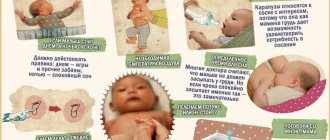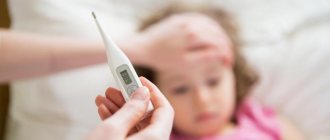Author's rating
Author of the article
Green Elena Stanislavovna
Otolaryngologist of the second category
Articles written
665
about the author
Parents are very worried when their child is sick. If the child’s voice is hoarse or a cough appears, the mother begins to check the temperature and ask the child where and what hurts. Often such care is not superfluous. It is better to stop the disease in time than to deal with its consequences.
Mechanism of symptoms
Waking up early in the morning, your child cannot even say a word. A child’s hoarse voice (cough) appears unexpectedly, and only then do parents begin to remember what caused the disease. Children are very sensitive to colds and viral diseases. A hoarse voice without a cough in a child occurs due to swelling of the ligaments, inflammation of the mucous membrane of the larynx and trachea. He manages to become hoarse precisely at night, when the vocal cords do not work.
When trying to talk to family in the morning, the ligaments become tense, and instead of words, a hoarse cough comes out of the child’s larynx. Parents start to really panic about this, and the child perceives his condition differently. Sometimes she cries, sometimes she endures. He becomes very ill from obvious symptoms of the disease:
- lack of voice;
- hoarseness;
- dry cough.
What to do if the child’s voice is hoarse, the child speaks hoarsely, or begins to cough? An experienced person immediately understands that the child is sick and will not go to kindergarten or school. He faces long-term treatment to restore his ligaments. Any tension in the voice can only worsen the patient's condition.
Reasons for voice changes in children of different ages
In infants
The voice of an infant can change as a result of physiological reasons without any apparent reason at the beginning of the second month of life, and this is associated with differentiation, restructuring and overstrain of the vocal cords. This is due to the baby’s adaptation to new living conditions. This condition goes away on its own.
Also, one of the main reasons for changes in the voice of a baby is observed with loud screaming and prolonged crying due to prolonged overstrain of the laryngeal ligaments.
In young children
Causes of hoarseness include:
- acute inflammation of the nasopharynx and/or larynx (laryngitis and laryngotracheitis) due to colds, viral diseases or childhood infections (measles, rubella, severe chickenpox, scarlet fever), often these pathologies are accompanied by swelling of the larynx - “false croup”;
- inflammation of the nose, pharynx and larynx of an allergic nature;
- adenoiditis;
- fear or severe stress;
- congenital stridor and other anomalies of the larynx;
- foreign body in the larynx;
- neoplasms on the vocal cords (polyps, fibroids, cysts).
In preschoolers
Most often, hoarseness in children is observed:
- for laryngitis and laryngotracheitis of a viral and bacterial nature, most often with parainfluenza, rhinosyncytial infection, pneumococcal lesions of the larynx, Haemophilus influenzae infection;
- for inflammation of the larynx due to childhood infections;
- with adenoid growths in the nasopharynx and adenoiditis;
- for acute pharyngitis and tonsillitis;
- for psychoneurological pathologies (neuroses, severe stress, fear);
- with pathology of the digestive tract with reflux of stomach contents from the esophagus into the nasopharynx;
- with neoplasms of the larynx.
In schoolchildren and teenagers
- acute and chronic inflammation of the nasopharynx with the transition of inflammation to the structures of the larynx;
- allergic laryngitis;
- overstrain of the vocal cords when shouting, singing, or talking for a long time;
- neurological pathology;
- voice mutation in boys during puberty;
- chronic gastrointestinal diseases;
- laryngeal injuries;
- laryngeal neoplasms
Causes of hoarseness and cough
Every disease has its own nature. A child's hoarse voice and cough can occur for various reasons:
- A viral infection enters the laryngeal mucosa;
- Complications from other diseases (ARI, sore throat, pharyngitis, bronchitis, influenza);
- Allergic reactions;
- Hypothermia of the body, when a cough and hoarse voice appear even in an adult;
- The transition of colds to a chronic form (bronchial asthma, pneumonia, tuberculosis).
Hoarseness with a cold
The most common cause of hoarse voice in children at any age is:
- colds;
- viral and bacterial infections.
Inflammation and swelling of the vocal cords of a cold origin occur as a result of hypothermia in a child.
In children, this in most cases develops due to instability of the thermoregulation system and reduced intensity of blood circulation in the hands and feet.
Experts recommend creating a comfortable microclimate in the room - maintaining the air temperature in the baby’s room at 22-23 degrees Celsius.
But this temperature regime is not suitable for all children; for some categories of children it is selected individually.
These include:
- premature babies;
- weakened children;
- children with perinatal pathology, signs of congenital infection and other somatic diseases.
It is also necessary to remember that there is a separate category of “heat-loving” young children, which is explained by incomplete differentiation of thermoregulation and these children can catch a cold from the parents’ harmless desire to harden the baby from the cradle.
You can understand that the selected temperature regime is not suitable for the baby by constantly cool arms, legs and nose of the child, which remain cold - this means that the temperature in the room should be higher than recommended.
Parents need to remember that each child is individual, so sleep and wakefulness, microclimate conditions, nutrition and other features of the baby’s growth and development are selected in accordance with the functional characteristics of the body.
Symptoms of the disease
A dry cough and hoarseness can be indicators of various diseases. Laryngeal stenosis leads to spasms of the airways. This becomes dangerous for the baby, especially between the ages of 0 and one year. A barking cough in a child leads to the fact that he does not sleep at night, suffocates, loses appetite, becomes nervous and irritable.
Such symptoms may indicate the development of laryngitis, pharyngitis, tracheitis, sinusitis, pneumonia, bronchitis. A small child may become hoarse if he has swallowed a foreign body or with reflux in the stomach. With hoarseness and the appearance of a dry cough, the child may generally experience asphyxia. It is not worth experimenting with treating a child, since everything can only be complicated.

What to do if a child has a hoarse voice and a cough
A cough with hoarseness in a child is the first sign of a serious illness, the causes of which parents need to find out immediately. Self-medication only delays the time allotted for diagnosis. When you hear your hoarse child and his sudden hoarse cough, try to act strictly according to the rules:
- check for foreign bodies in his mouth;
- give him a warm drink (tea, milk);
- provide air flow into the room;
- Seek medical help as soon as possible.
If these are asthmatic, allergic symptoms or small objects entering the respiratory tract, asphyxia and instant death may occur. Only specialists can help the child in the near future.
When visiting a doctor, parents need to be told about all the circumstances under which the child became ill. This way, the doctor will be able to quickly make the correct diagnosis and prescribe treatment.

Treatment for hoarse voice
It is easier to cure a child at the initial stage of the disease, when the causes have already been established. How to treat if the child has hoarseness and coughs? These symptoms often cause swelling of the larynx and lead to suffocation. Therefore, all efforts of doctors are aimed at relieving swelling and restoring normal breathing. All procedures must be carried out in a hospital setting. After successful restoration of the voice and removal of swelling, treatment of the diagnosed disease continues. You cannot do without drug treatment if your voice remains hoarse and your cough does not go away.
Drug therapy
To return a hoarse voice and to combat a dry cough, the child is prescribed treatment with mucolytic and expectorant drugs. They alleviate the general condition of the sick child and lead to the removal of sputum accumulated on the mucous membrane.
If hoarseness is a consequence of another disease or becomes chronic, doctors prescribe antibiotics and antibacterial agents to kill the infection. The task is being accomplished - to prevent complications in the child’s body.
If the disease proceeds without any particular complications (fever, weakness, swelling), traditional medicine recipes can be used for treatment.
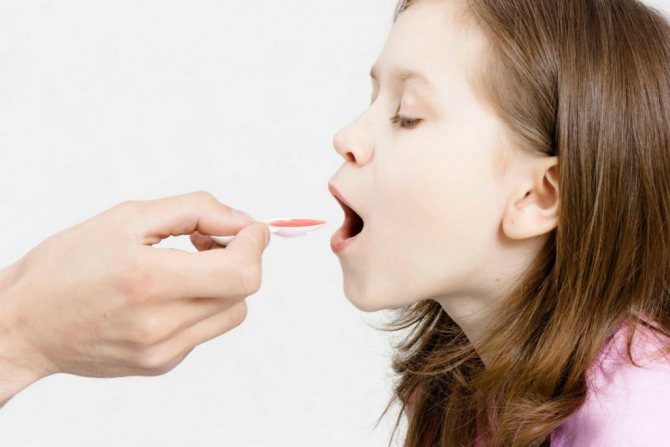
Inhalations
A child's hoarse cough can be treated using proven methods. This method of treating diseases of the nasopharynx, larynx, cough symptoms and hoarseness of voice is inhalation. They are carried out with the aim of directly influencing the inflamed mucous membranes. For dry cough, inhalation using medicinal oils and herbal infusions has a favorable result:
- The mucous membrane is evenly moistened.
- The removal of sputum is accelerated.
- Medicinal components speed up the overall course of treatment.
- The symptoms of the disease are blocked, preventing it from becoming chronic.
Inhalations can be performed in special physiotherapy departments where special nebulizers are installed. This device is quite affordable for home use. The convenience of a nebulizer is that it does not require inhalation and exhalation of air. The liquid in it is sprayed and enters the respiratory tract in aerosol form. A dry cough immediately subsides and softens. In the absence of a device, they use the “grandmother’s” method: they inhale medicinal vapors over a kettle. Inhalations can be wet (not higher than 300 C) and warm-moist (up to 400 C), as well as using potato decoction, with the addition of medicinal herbs (chamomile, calendula, plantain), antiseptics (tincture of sage, menovazin, etc.).
It is necessary to take into account the general standing of the patient and the conditions under which inhalation is prohibited. These may be asthmatic, allergic symptoms, heart failure, individual drug intolerance, epilepsy and other chronic diseases.
Traditional treatment
Traditional healers have a whole range of medicinal herbs, ointments, and tinctures that can help parents cure their child’s hoarseness and dry cough without the intervention of official medicine.
If there is no threat of asphyxia and serious complications of the disease, you can use folk recipes:
- Dry mucous membranes require softening, so you can give your child warm milk and honey, dissolving a piece of butter.
- Medicinal infusions for dry cough should be drunk warm 4-5 times a day. Includes:
- coltsfoot leaves;
- plantain;
- chamomile;
- tricolor violets;
- oregano;
- calendula;
- wild rosemary;
- calamus root;
- licorice root.

You can safely add vitamin-rich rose hips, dry raspberries or blueberries. The drink will restore immunity, increase vitality, and soften dry cough. Herbs can be infused separately or mixed if the child is not allergic to individual components.
- Honey is consumed separately, 1 teaspoon. It has a softening effect on inflamed mucous membranes.
- In the morning, drink a glass of warm grape juice with a spoon of honey.
- Black radish juice with honey or sugar has long been used. To do this, take a large root vegetable, make a hole and cover it with sugar or honey. The resulting juice is taken a teaspoon 3-4 times a day.
- If a child coughs to the point of exhaustion, take a spoonful of sugar, melt it in a hot frying pan, and pour in 100 ml of water. Give the resulting solution to your child to relieve laryngeal spasms.
There are many more offers for healing hoarseness and cough, but you need to choose your own recipe based on the symptoms of the disease, as well as the individual characteristics of the child’s body.
Compresses
In folk medicine there are many tips on how to treat wheezing and coughing with compresses and rubbing. The method is effective, but is not used at high temperatures and allergic reactions to the skin.
For a compress you can take:
- Cabbage leaf smeared with honey, which is applied to the child's chest and back. The place of the compress must be insulated.
- Mashed boiled potatoes (up to 300 C), which are applied to the chest for 40-50 minutes.
- Small flat cakes made from boiled chopped onions, vegetable and camphor oil, dry mustard and flour. They should be applied to the back and chest for no more than a couple of hours. Make sure there is no strong burning sensation from the mustard.
They also use ordinary mustard plasters, various tinctures, and vegetable oils for rubbing. The choice is also individual.
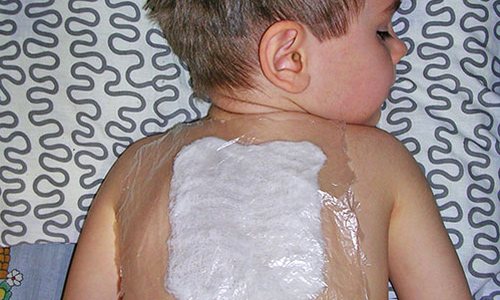
Identification of medical history and treatment of the disease
Before you do anything about the symptom that has arisen - a hoarse throat, you should find out the real reason for the appearance of such pathogenesis.
Condition No. 1: ligament strain
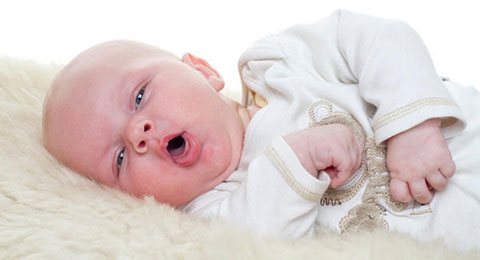
The best option is to overstrain the vocal cords by screaming; the child may experience discomfort, has been wet for a long time, is hungry, does not have enough food, needs complementary feeding, wants to sleep, or simply feels scared or bored. For such reasons, the baby needs to be reassured, changed diapers, picked up, given a warm drink of water with sweet syrup or a regular pacifier dipped in some kind of sweetness. With temporary calm, if everything is done correctly, the wheezing will soon go away on its own.
If wheezing is accompanied by negative factors, such as fever, redness of the throat, rash on the body and other manifestations, then this is a serious reason that requires immediate intervention - treatment.
Condition No. 2: scarlet fever, measles, chickenpox
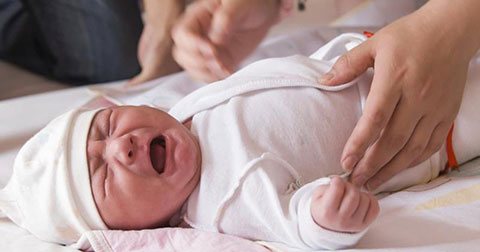
Hoarse throat, red rash on the body, fever - can occur with infectious diseases such as scarlet fever, measles, chickenpox. For these diseases, the presence of a professional is necessary. To alleviate, as well as prevent negative consequences, while waiting for an ambulance, it is necessary to reduce body temperature to the maximum permissible level - in order to prevent the occurrence of seizures.
Dr. Komarovsky recommends drinking plenty of fluids in such cases, given the symptoms of the disease, fluid is a vital factor in alleviating the symptoms of the disease.
Condition No. 3: pneumonia, croup
If the symptom of a hoarse throat is accompanied by diarrhea with a change in the normal color of stool, nausea - this could be pneumonia, pneumonia or croup. To treat such severe illnesses, immediate hospitalization is required.
Condition No. 4: sore throat
A hoarse voice, refusal to eat food, liquids, and strong salivation occur with difficulty and pain during swallowing; these factors indicate diseases associated directly with the throat - sore throat, pharyngitis, laryngitis, swelling and stenosis of the larynx, scleroma.
The risk of negative consequences depends on the severity of the disease; a diagnostic visit to a pediatrician is required; each individual history has specific treatment. The baby’s throat must be treated with special means as prescribed by the doctor; antibiotics must be taken to neutralize the action of pathogenic bacteria.
Condition #5: Allergy
A hoarse throat may indicate allergic reactions of the body, bronchial asthma or other chronic diseases of the upper and lower respiratory tract.
Pediatrician Komarovsky does not recommend self-diagnosis of the disease. But you need to examine your child immediately at the first signs - when the voice begins to change timbre, in order to take timely measures to prevent possible consequences.



